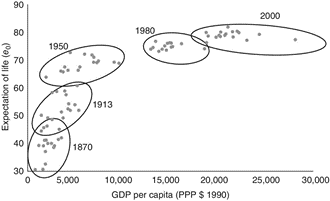Individual memories are subject to fading, and cultural values change in time, making it difficult to compare well-being over the past few decades. Economically, we are better off than we were twenty, thirty or fifty years ago, as we live longer and our incomes are higher.

Maybe it is true that life is just a remembrance of childhood in slow motion. It is pleasant to recall memories, as even some sorrowful events may become beautiful, through the deepness of nostalgia. Some would say that nostalgia is strongest among those who fear for their security and forgot that the good old days were not that good. Remembering is telling a story, rather than an accurate replay of the past.
We consider it a blessing to possess a good memory, but recent advancements in neuroscience suggests that forgetting enables us as individuals, and as a species, to move forward. Jorge Luis Borges anticipated this discovery by half a century as he wrote the story of "Funes el Memorioso", a peasant skilled with the ability of remembering absolutely everything: "We, at a stroke, perceive three cups lying on a table; Funes would see all the shoots and clusters and fruit comprised by a vine. He knew the shapes of the southern clouds at dawn on April 30, 1882, and could compare them in his memory with the streaks on a book of Spanish cover that he had seen only once and with the swirls on the foam raised by an oar in the Río Negro on the eve of the battle of the Quebracho."
Not possessing the power to forget, poor Funes was overwhelmed by the details of the world around him and spent the rest of his life hardly even daring to lift a finger. As most of us do not suffer from the "Funes' syndrome", our memories and perceptions of the past tend to focus on eventful periods, regardless of the emotions - happiness or sadness - that we felt in those times. Ordinary days leave minor impressions and tend to disappear from our memory.
Personally, I have fond memories of the regular train journeys from my hometown in Sicily to Milan during the university years: nearly 24 hours spent in overcrowded train wagons, sometimes forced to sleep laying down on the corridor floors, and chatting with the other passengers, anxiously awaiting to cross by ferry the Straits of Messina at dawn. Individual memories are subject to change and fading, and despite their limitations, they are essential for our thinking and influence our behaviour.
As members of a family, a generation or a nation, we also acquire collective memories that create a form of affiliation within the group. In Aleida Assmann's words: "Groups indeed define themselves by agreeing upon what they hold to be important, to which story they accord eminence, which anxieties and values they share."
On this topic, Ronald Inglehart argues that western societies experienced an intergenerational value change since the 1970s; younger generations tend to give top priority to such goals as environmental protection, freedom of speech, and gender equality over economic and physical security. The World Value Surveys show evidence of massive cultural change, together with the persistence of distinctive cultural traditions in western countries. Cultural change has profound socio-economic implications, which we will not explore here.
Crucially, as the value priorities changed since the 1970s, we can only meaningfully compare past and present welfare merely using basic indicators of individuals' well-being, such as income growth, summarized by GDP, and life expectancy.
Live long and prosper
Economists are well aware that GDP is a flawed measure of economic welfare. Joseph Stiglitz, Amartya Sen and Jean-Paul Fitoussi proposed a set of indicators to improve GDP: health, education, leisure, environment, political voice, social connections, recently compiled by the OECD. According to OECD, since 2010 “people’s well-being has improved in many respects, but progress has been slow or deteriorated in […] how people connect with each other and their government. For a long-term perspective on well-being, Angus Maddison’s data plotted in Figure 1 show the relation between the increase in life expectancy in 16 western countries and GDP per capita.
The core message is quite clear: from the 1950s to the 2000s, the 16 countries experienced improvements in life expectancy and large increases in wealth.
Changing value priorities and fading memories are impractical measures for comparing past and present well-being. When we look back, we will always find some everlasting summers, a few glory days, but also the personal hopes, the anxieties and the values that shaped our behaviour and future decisions.
Economically, we are better off than we were twenty, thirty or fifty years ago, as we live longer and our incomes are higher.
–
–


